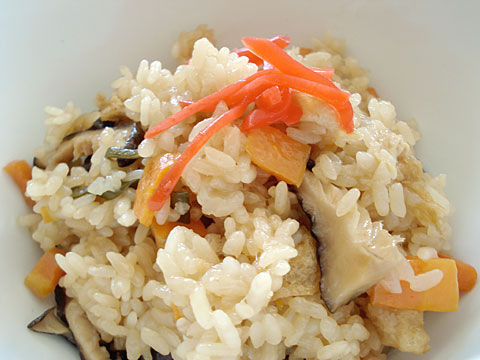Okowa: Sticky rice with all kinds of good things

Okowa (おこわ)is the name given to a type of rice dish in which sticky glutinous rice is mixed with all kinds of vegetables or meat and steamed. It's related to Chinese sticky rice, which you might have had as part of a dim sum meal. If the rice mix is steamed in small packets, wrapped in a bamboo leaf, it's called chimaki. You can mix any number of things in with the rice to make it a complete meal in itself.
The rice used is not the usual Japanese rice - it's short grain glutinous rice, often sold as mochi rice (餅米). (See Looking at rice for the differences between rices.) It's the kind of rice that mochi rice cakes are made from. When cooked, it becomes very sticky - the grains cling together much more than regular medium-grain rice does. Because of this, anything made with it is very filling. (Some people like to mix mochi rice and regular rice together, but I like the full-on stickiness of all mochi rice.)
By mixing a lot of vegetables and protein (the gu) in the rice, okowa can become a complete meal unto itself. I like to make it with all-vegetable ingredients or with added meat, depending on my mood and what I plan to make besides it. The base is the same though. Okowa is meant to be eaten at room temperature, makes great onigiri, and freezes very well, so it's a nice change of pace for bentos from regular rice.
Okowa makes me feel very nostalgic somehow - it reminds me of my grandmother. It's an old fashioned, very Japanese dish.
I've given two methods of cooking this: in a rice cooker, and in a microwave. Either way, it turns out great.
Recipe: Okowa
The base:
- 2 cups mochi rice or short-grain glutinous rice
- 1 Tbs. dark sesame oil
- 2 cups minus 2 Tbs. dashi stock - traditional or vegan, or 2 cups of water with some dashi stock granules
- 2 Tbs. mirin
- 1 1/2 Tbs. soy sauce
- Pinch salt
- 1 tsp. brown sugar (optional)
The things you add to it - vegan version:
- 5 dried shiitake mushrooms, soaked and re-hydrated (you can use the soaking liquid as the stock)
- 1 large carrot
- 3 aburaage - fried tofu skins; or 6 inarizushi skins, well drained
- 1 small piece (about 1 inch square) fresh ginger
The things you add to it - omnivore version:
- 4 dried shiitake mushrooms, soaked and re-hydrated (you can use the soaking liquid as the stock)
- 1 large carrot
- 1 cup of ground pork or pre-cooked and chopped meat (e.g. leftover pork roast, turkey, etc.)
- A few green onions, enough to produce 1/4 cup chopped
- 1 small piece (about 1 inch square) fresh ginger
Wash the mochi rice as per the instructions here. Strain into a sieve or colander and let it sit a while to drain away all the water.
Mix the sesame oil with the drained rice. Add the other 'base' ingredients, mix well and let it steep for at least 20 minutes.
In the meantime, dice the carrots, chop up the shiitake mushrooms, finely chop the ginger, and cut up the fried tofu skins. If you're doing the meat version, chop up the meat if needed, and chop up the green onions.
If you're cooking this in a rice cooker, put the rice, liquid and the 'things you add to it' into a rice cooker, and cook using the regular setting. When it's cooked, fluff it up well and take it out of the cooker. Do not keep okowa in the rice cooker the Keep Warm setting - it will start to go funny rather fast.
If you're using a microwave, put the rice, liquid and the 'things you add' in a bowl. Cover the bowl with plastic film. Microwave on HIGH for 12 minutes. Take out, and mix well. Re-cover, and microwave on HIGH for another 3 minutes. Mix well and recover. Let it sit, covered, for at least 10 minutes. (This method was featured on a recent issue of "Today's Cooking Beginners" (きょうの料理ビギナーズ); they nuked it for 12 minutes - then 2 minutes - 2 minutes, but I found that 12 minutes - 3 minutes works fine.)
Let the okowa cool to room temperature. You can use it as-is, garnished with a little pickled red ginger as shown in the photo. You can also make onigiri (no filling needed) - just wet your hand slightly and form into balls, or use the plastic wrap method (without the salt). The rice will stick together very well.

You can freeze okowa - I like to make them into onigiri first. Then you can take one one onigiri at a time.
Variations
You mix in any kind of vegetable and/or meat combination with the basic rice and flavorings. Some traditional additions include fresh mushrooms of all kinds, boiled bamboo shoot, precooked chestnuts, sweet potato, various mountain greens, and so on. On the meaty side you could add roast duck, char siu pork, finely diced sausage...
You can also vary the flavor by using another oil instead of sesame, using chicken stock instead of the dashi, and so on. Experiment!
If you enjoyed this article, please consider supporting this site by becoming my patron via Patreon.
